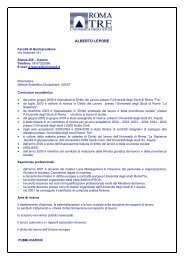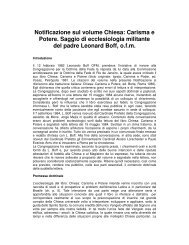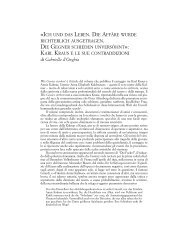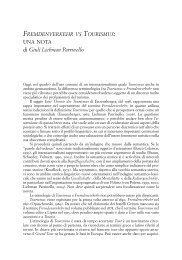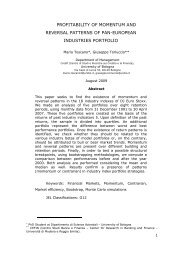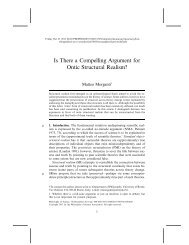large debt financing syndicated loans versus corporate bonds
large debt financing syndicated loans versus corporate bonds
large debt financing syndicated loans versus corporate bonds
Create successful ePaper yourself
Turn your PDF publications into a flip-book with our unique Google optimized e-Paper software.
5.3 Larger sample with smaller firms<br />
In previous sections, the focus was on firms that are <strong>large</strong> and credible enough to be<br />
able to access public bond and/or the <strong>syndicated</strong> loan markets. In fact, our analysis<br />
includes only those observations where a firm issues a certain type of <strong>debt</strong><br />
successfully.<br />
Hence, we en<strong>large</strong> the dataset by incorporating those firms and year observations in<br />
which firms do not tap any <strong>debt</strong> market to comprise 3,626 firms with 24,423<br />
observations. Compared with the previous sample, we add a further 2,228 listed nonfinancial<br />
European firms to the sample. These firms did not issue any <strong>debt</strong> in either<br />
the bond or the <strong>syndicated</strong> loan markets between 1993 and 2006. Overall, they are<br />
relatively smaller than the original sample with a mean asset size of USD 791 million.<br />
The ability of smaller firms to borrow from these segments of the credit markets may<br />
be limited owing to the size of their <strong>financing</strong> needs. They could also lack the credit<br />
quality, which will reflect in their financial status.<br />
We assume that these firms have been <strong>financing</strong> themselves either through bilateral<br />
bank <strong>loans</strong> or other types of private <strong>debt</strong>. 10 In this specification, the dependent variable<br />
choice of <strong>debt</strong> takes the value of 0 if the firm does not issue any <strong>debt</strong>, 1 if it receives a<br />
<strong>syndicated</strong> loan, 2 if it issues a bond and 3 if it taps both <strong>debt</strong> markets simultaneously<br />
within the same year. We run a multinomial logistic regression with random effects<br />
using all observations, with no <strong>debt</strong> issuance being the base outcome. Table 4 displays<br />
the results 11 .<br />
10 Ideally, the analysis could have given better results if we had had the opportunity to include bilateral<br />
<strong>loans</strong> and other private <strong>debt</strong> incurred by the firms in our sample. However, owing to data unavailability<br />
we rely only on the findings of previous studies.<br />
11 To check for robustness we ran similar regressions with our original sample of 1,377 firms by<br />
including the years in which they do not issue any <strong>debt</strong>. We find that firms' characteristics affecting the<br />
choices of alternative <strong>debt</strong> options (bond, loan or both within the same year) are similar. This is due to<br />
the fact that the differences between the alternative choices are only present at marginal levels after the<br />
firms tap the market. However, these unreported findings only capture the characteristics affecting the<br />
firms’ decision of whether to borrow (via any of the three options) or not to borrow (no issuance) at all.<br />
24 ECB<br />
Working Paper Series No 1028<br />
March 2009




